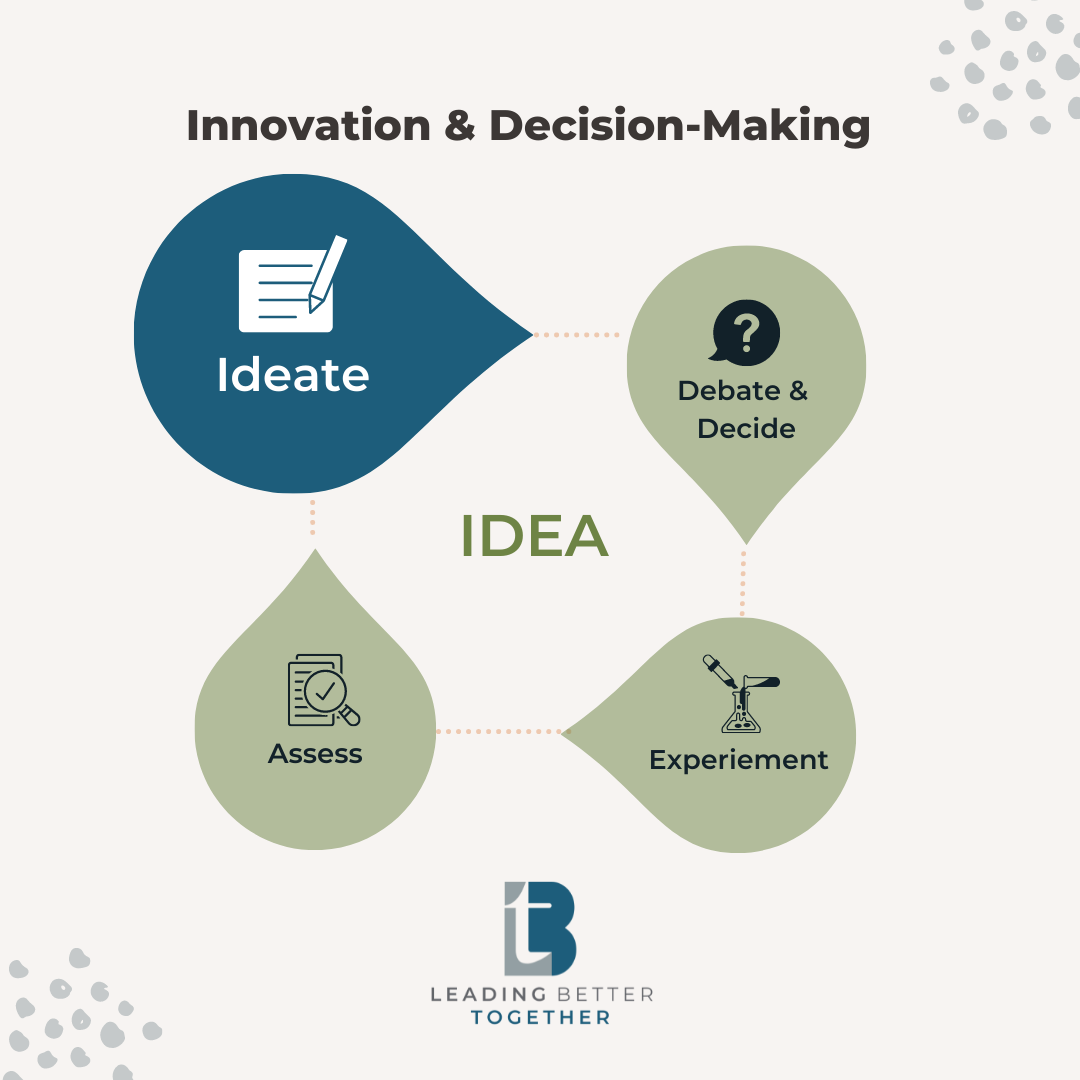Innovation: The More Ideas the Merrier
Jul 27, 2022
Innovation goes beyond simply generating new or more ideas. It’s surfacing ideas, evaluating them, deciding what to try out and assessing what needs to happen to make it better or do it differently. It’s an ongoing process that is at the heart of innovation.
Ideating on its own often results in starting and stopping before ideas fully evolve. Good opportunities may be missed and energy wasted if we short circuit innovation. As leaders, we can stay ahead of the change and see the possibilities on the horizon by cultivating ideas within the cycle of innovation and decision making.

Generating ideas involves brainstorming a number of ideas. The more the merrier, right? To move beyond just a quantity of ideas, focus also on enhancing quality by doing a little homework before brainstorming and pausing to expand ideas before evaluating. Think of ideating in three phases: (1) Observation (2) Brainstorming (3) Expanding
Observation:
A good practice for every leader is to engage observation before brainstorming. Think beyond just reading a report with data about the problem and move into experiencing the problem with your own “senses”. Think about things like:
- Take a “field trip” to experience the physical surroundings
- Talk to customers or clients to hear their stories
- Watch people and note their behaviors in relevant situations. Record what you notice in an observation journal before ideating solutions
- Practice mindfulness activities daily to heighten your observation abilities
- Regularly Engage in active reflection on the observations you are collecting
You may be surprised at how observation will open your awareness to alternative possibilities and improve the quality of ideas.
Key Question: What do we notice when …?
Brainstorming:
Fueled by your observations, now you can enter brainstorming more prepared. The beauty of brainstorming is generating more and more ideas. Quantity is your focus in this phase. Here are a few ways to generate quantity:
- ALL ideas are welcome – repeat the invitation to contribute often. Consider asking people directly for their thoughts if you have not heard from them yet.
- Write these ideas down – to engage visual stimuli for more ideas.
- Set a timeframe – people have different levels of energy for brainstorming. Start with 15 minutes and see if the ideas are still coming at a rapid pace at the end of the time period. If so, consider going for another block of time.
- Ask silly questions - to stimulate thinking in the group. E.g. If you were on the moon, how would you …?
- Break up in pairs to do some initial brainstorming to encourage active participation from everyone present.
- Hold onto to moments of silence to give people time to think.
- Keep periodically repeating the key question to surface more ideas.
Key Question: How might we ….?
Expanding:
Often in brainstorming, the natural tendency of the group is to narrow the conversation down. Conversations may prematurely start circling around a concept or a particular theme of ideas. That is exactly the time in the conversation to suspend evaluation and ask an expanding question or adopt an activity that will help you avoid the trap of pre-screening ideas while brainstorming.
- Take a break and come back to brainstorming – leverage the back burner thinking in between sessions that may fuel more ideas
- Ask team members to share the observations that led to a particular idea to stimulate thinking of others in the group
- When you think you are done, ask the question again – some people access ideas readily, others need to build up to the notion of sharing an idea.
Key Question: What else . . . ?
What’s next?
Too small of a pool of ideas will likely result in fizzled innovation. Adding observation and expanding activities to your brainstorming will increase the pool of ideas. You can also improve quality – and maybe add in some complexity – with a broader range of diversity in the ideas. Let’s talk about that in the next blog.
What is the hardest part about brainstorming for you and your team? What has worked to generate more ideas for you? Have you seen the connection between more ideas and better ideas? Comment below! Email me your observations and questions to further the conversation.
#adaptivechange
#innvoativeteams
#innovatedecisions
#decisionmakinghabit
#newwaystodecide
#howmightwe
Stay Connected
Get resources, motivation, and leadership support
delivered straight to your inbox.
We hate SPAM. We will never sell your information, for any reason.


